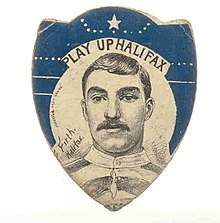Frederick Firth
Frederick "Fred" Firth (1870 – February 1936) was an English rugby union, and professional rugby league footballer who played in the 1890s and 1900s. He played representative level rugby union (RU) for England, and at club level for Halifax, as a wing, i.e. number 11 or 14, and representative level rugby league (RL) for Yorkshire, and at club level for Halifax (Heritage № 16) (two spells), and Wakefield Trinity (Heritage № 80), as a wing, or centre.[3] Prior to Tuesday 27 August 1895, Halifax was a rugby union club.
 Baines Cigarette card featuring Frederick Firth | ||||||||||||||||||||||||||||||||||||||||||||||||||||||||||||||||
Personal information | ||||||||||||||||||||||||||||||||||||||||||||||||||||||||||||||||
|---|---|---|---|---|---|---|---|---|---|---|---|---|---|---|---|---|---|---|---|---|---|---|---|---|---|---|---|---|---|---|---|---|---|---|---|---|---|---|---|---|---|---|---|---|---|---|---|---|---|---|---|---|---|---|---|---|---|---|---|---|---|---|---|---|
| Full name | Frederick Firth | |||||||||||||||||||||||||||||||||||||||||||||||||||||||||||||||
| Born | 1870 Cleckheaton, England | |||||||||||||||||||||||||||||||||||||||||||||||||||||||||||||||
| Died | February 1936 (aged 65–66) Olneyville, Providence, Rhode Island, United States | |||||||||||||||||||||||||||||||||||||||||||||||||||||||||||||||
Playing information | ||||||||||||||||||||||||||||||||||||||||||||||||||||||||||||||||
Rugby union | ||||||||||||||||||||||||||||||||||||||||||||||||||||||||||||||||
| Position | Wing | |||||||||||||||||||||||||||||||||||||||||||||||||||||||||||||||
| ||||||||||||||||||||||||||||||||||||||||||||||||||||||||||||||||
Rugby league | ||||||||||||||||||||||||||||||||||||||||||||||||||||||||||||||||
| Position | Wing, Centre | |||||||||||||||||||||||||||||||||||||||||||||||||||||||||||||||
| ||||||||||||||||||||||||||||||||||||||||||||||||||||||||||||||||
Background
Fred Firth was born in Cleckheaton, West Riding of Yorkshire, England, and he died aged 65–66 in Olneyville, Providence, Rhode Island, United States.
Playing career
International honours
Fred Firth won three caps for England (RU) while at Halifax in 1894 against Wales, Ireland, and Scotland.[1]
Change of Code
When Halifax converted from the rugby union code to the rugby league code on Tuesday 27 August 1895, Fred Firth would have been approximately 25. Consequently, he was both a rugby union, and rugby league footballer for Halifax.
Club career
Fred Firth made his début for Wakefield Trinity during October 1899, and he played his last match for Wakefield Trinity during the 1900–01 season, he appears to have scored no drop-goals (or field-goals as they are currently known in Australasia), but prior to the 1974–75 season all goals, whether; conversions, penalties, or drop-goals, scored 2-points, consequently prior to this date drop-goals were often not explicitly documented, therefore '0' drop-goals may indicate drop-goals not recorded, rather than no drop-goals scored. In addition, prior to the 1949–50 season, the archaic field-goal was also still a valid means of scoring points.
References
- "Statistics at en.espn.co.uk". en.espn.co.uk. 31 December 2017. Retrieved 1 January 2018.
- "Statistics at rugbyleagueproject.org". rugbyleagueproject.org. 31 December 2017. Retrieved 1 January 2018.
- Williams, Graham; Lush, Peter; Farrar, David (2009). The British Rugby League Records Book. London League. p. 178. ISBN 978-1-903659-49-6.